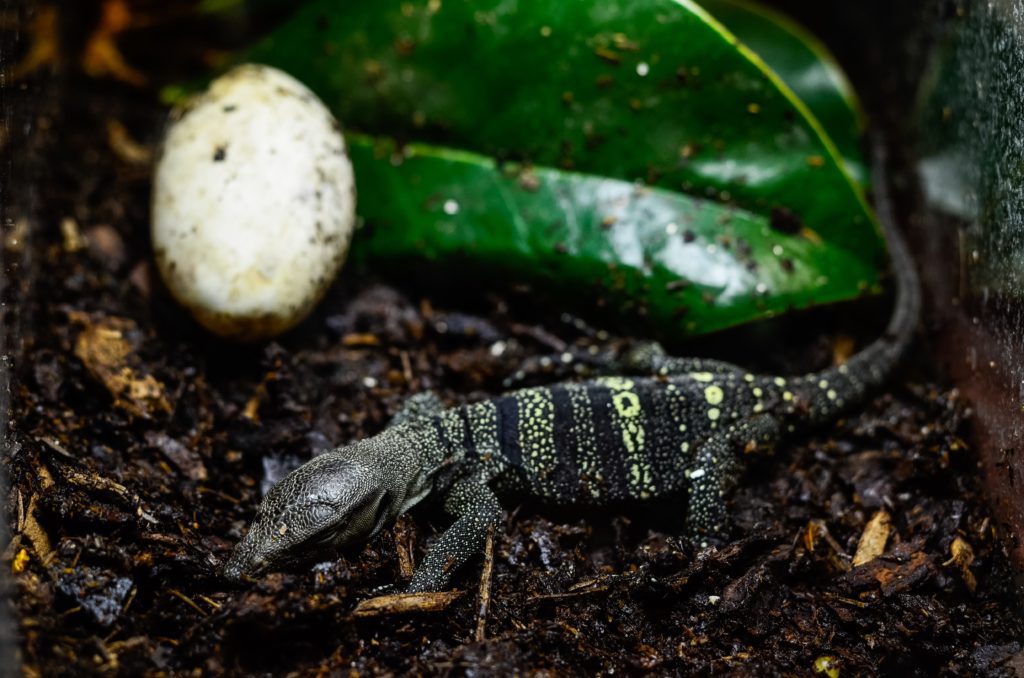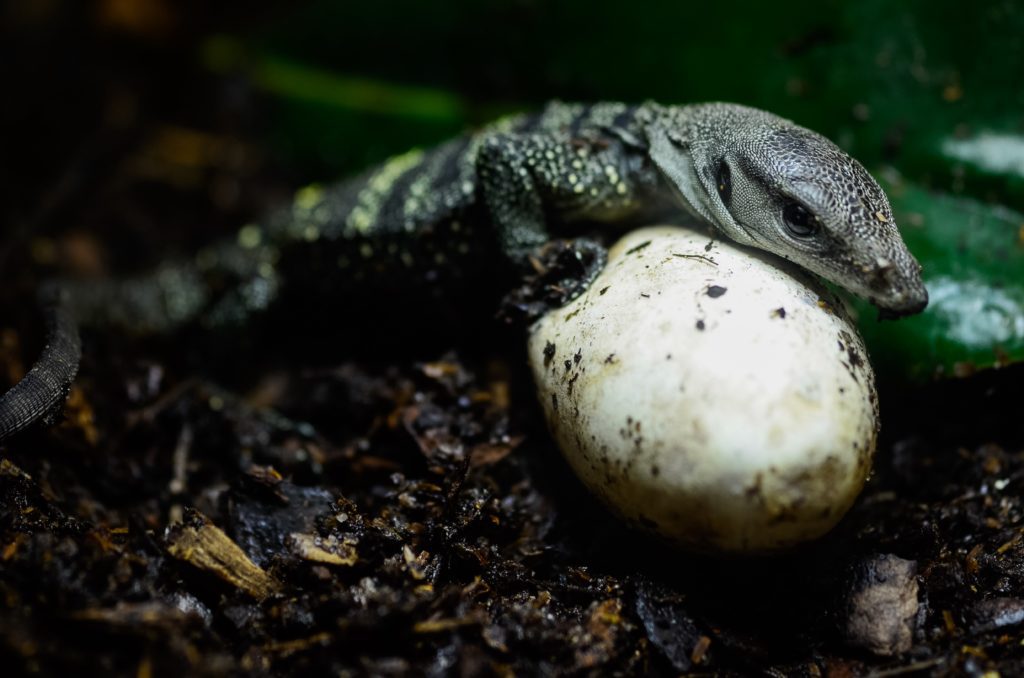Spinulosus Birth at Animal World & Snake Farm Zoo
Written by Hannah Mulligan and Caleb Harris
On February 22nd, 2016, Animal World & Snake Farm Zoo was proud to announce the birth of three Solomon Island spiny monitors— the first three of their kind to be captive bred and born within the United States.
Affectionately known as “spinnies,” the Solomon Island spiny monitor, Varanus spinulosus, is a medium-sized lizard native to the central Solomon Island of Isabel and San Jorge, a smaller, nearby island. Though the International Union for Conservation of Nature has listed the species as “of least concern,” research has proven that due to limited data on the species, its population cannot be correctly verified.
Many spinulosus were imported during the 1990’s, under the common name “mangrove monitor” due to increased desirability in the pet trade. Unfortunately, the importation of spinulosus had not resulted in successful establishment of the species in captivity — the wild-caught lizards struggled to survive and effectively reproduce.
Animal World & Snake Farm Zoo was fortunate to receive our spinulosus by donation. The original owner had noted that the lizards had been in captivity for seven years without reproduction. Until the time of donation, they had been kept in pairs.
After considerable research, we disappointed to find minimal information of this species. We then turned to a few existing records of spinulosus observation in the wild to develop a healthy breeding strategy.
We first converted an existing enclosure into the spinulosus habitat. The “pond” area (built at 96 inches by 102 inches) ensures high humidity and makes up two thirds of the enclosure. The land area (96 inches by 48 inches) is filled with cypress mulch four inches deep.The entire enclosure is 96 inches high and is furnished with basking areas and climbing branches. A small pump provides rudimentary water filtration and creates a small fountain. Live pothos plants are planted in miscellaneous places throughout the upper area of the enclosure (out of the lizard’s reach). After observing their behavior (such as scuffling, hierarchy establishment and copulation), we designed and installed three nest boxes into the ha
bitat. Each box measures 17 inches long by 12 inches wide by 16 inches high. One of the three boxes is set up 44 inches above the land area while the other two are placed 60 inches over the pond.
Supplemental heat is provided by four lamps spread across the entirety of enclosure— three of the lights provide warmth to the 8-foot log in the enclosure and create three defined hot spots, each at different elevations. A fourth lamp was placed over one of the nest boxes. The only bulbs used are two infrared heat bulbs (for constant warmth) and two full spectrum mercury vapor “powersun” bulbs (for UV exposure and photoperiod). Both the lamps and ambient temperature of the building maintain a cool temperature on the dry areas (about 75-77 degrees fahrenheit during the day, with a slight 3-4 degree drop during winter nights). Ambient temperature at both perch elevation and at the height of the nest boxes stays within 79-82 degrees fahrenheit. Temperatures along the basking log range from 82-120 degrees, with the highest elevation providing the highest temperature. The basking area over the nest box (where a mercury bulb is provided) reaches 97-99 degrees.
Because these lizards are very active during the daytime, they are often observed “foraging” in the mulch that is placed around the dry, land area. Similarly, this is the area they’ve chosen for reproductive activity. We’ve observed basking only along the log, where one animal occupies each of the hot spots— the most dominant lizard utilizes the hottest spot. Notably, we have never observed fights over the warmest spots; these spinnies have had relatively gentle scuffles compared to other varanids, though enclosure size relative to animal size may account for this observation.
The basking area atop the nesting box is typically used by multiple lizards at once. The red heat lamps are used to raise body temperature in the morning— afterwards, spinnies are found lounging in the warmth for the remainder of the day.
Adult mice are a popular food item for our spinulosus, along with insects and raw lean meat. Artificial and heavily ground food, such as cat food or ground turkey, has been offered unsuccessfully. Aggression and fighting over food is rare— oftentimes, the more submissive lizards will refuse to eat until the dominant, active lizards have eaten.
When we discovered the first clutch, it was found within a planter that was partially filled with potting soil. We’d thought the planter was inaccessible to the lizards and were surprised by their dexterous climbing ability when they were found in the planter. The nest box was seven feet off the ground— the female was able to access the box through the bottom by using the decorative trim. She had spent four days prior to oviposition almost entirely in the box.
On September 30th, 2015 at 8:00 am, I’d peered into the box and was greeted by a defensive, hissing mama-spinnie and five white eggs. Despite the unfavorable conditions they were laid in, all five eggs appeared to be fertile. I removed the mother lizard, careful not to disturb the eggs. The eggs were then set up on damp vermiculite and placed into an incubator insi de a 9.75 inch wide by 3.75 inch tall deli container with small holes at two-inch intervals around the circumference of the lid.
The eggs were incubated at a temperature range of 85-87 degrees fahrenheit and were checked daily, mostly for moisture content. Approximately half way through incubation, we’d noticed small dents beginning to form on each of the eggs. Water was added to moisten the vermiculite and the eggs were full and healthy looking the following day.
Two of the embryos died after three weeks of incubation. The three remaining eggs stayed healthy. On February 22, 2016, the first baby pipped and we were greeted with the first tiny, wriggling baby spinulosus.
The crack in the egg was further opened to ensure the babies’ access to fresh air. Because many monitors die full-term from not being able to fully hatch from the egg, we made the decision to cut last two eggs at the 48-hour mark, regardless of their hatching progress.
After twenty-four hours of pipping, the first baby fully emerged from the egg. It was set up in an incubator on paper towel moistened with diluted betadine (to help absorb of the rest of the yolk). Another twenty-four hours had passed and neither of the remaining eggs showed any signs of hatching and were cut. Our discovery was disappointing: the poorer looking egg held a fully developed baby that had perished some time earlier, presumably within the week prior to the birth of the healthy baby. The other egg held an underdeveloped, still living baby, half the size of the healthy baby. It was kept in an incubator with the egg still intact. The area we’d cut open was covered with moist paper towels to absorb yolk and keep the undersized baby alive. In the end, the baby did not live.
At this point, Animal World & Snake Farm Zoo has only been aware of one other clutch that had been laid. At 8:00 am on March 26th,, we had noticed the clutch, but the eggs were destroyed.
Continued surveillance of the adult spinulosus has revealed many notable observations: the lizards continue to court one another on the ground and come down from the hot spots to feed. Basking behavior remains consistent, as do activity time.
We are continuously studying the breeding behavior in the hopes of being able to modify the nesting areas for successful egg laying. We are optimistic that our surveillance and exhibitory modifications will provide us with sustained reproductive success as well as the opportunity to further our understanding of this incredible species.
Check out the entire article in the Summer 2016 edition of the Zoological Association of America Journal.


